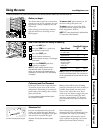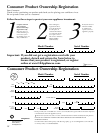
Broiler Pan & Grid
Do not clean the broiler pan or grid in a
self-cleaning oven.
After broiling, remove the broiler pan
from the oven. Remove the grid from the
pan. Carefully pour out the grease from
the pan into a proper container.
Wash and rinse the broiler pan and grid
in hot water with a soap-filled or plastic
scouring pad.
If food has burned on, sprinkle the grid
with detergent while hot and cover with
wet paper towels or a dishcloth. Soaking
the pan will remove burned-on foods.
Both the broiler pan and grid may be
cleaned with a commercial oven cleaner.
Both the broiler pan and grid can also be
cleaned in a dishwasher.
After broiling, remove the broiler
pan from the oven.
Do not store a soiled broiler pan and
grid anywhere in the oven.
Safety Instructions
Operating Instructions Care and Cleaning
Troubleshooting Tips Consumer Support
The gasket is designed with a gap at the
bottom to allow for proper air circulation.
Do not rub or clean the door gasket—
it has an extremely low resistance to
abrasion.
If you notice the gasket becoming worn,
frayed or damaged in any way or if it has
become displaced on the door, you should
have it replaced.
Oven Shelves
Clean the oven shelves with an abrasive
cleanser or soap-filled scouring pad.
After cleaning, rinse the shelves with
clean water and dry with a clean cloth.
NOTE: The oven shelves may be cleaned in the
self-cleaning oven. However, the shelves will
darken in color, lose their luster and become hard
to slide if cleaned during the self-cleaning cycle.
You can wipe the shelf supports with cooking
oil after self-cleaning to make the shelves slide
more easily.
19
www.GEAppliances.com
To clean the inside of the door:
■ Because the area inside the gasket is
cleaned during the self-clean cycle, you
do not need to clean this by hand.
■ The area outside the gasket and
the door liner can be cleaned with a
soap-filled scouring or plastic pad,
hot water and detergent. Rinse well
with a vinegar and water solution.
To clean the outside of the door:
■ Use soap and water to thoroughly
clean the top, sides and front of the
oven door. Rinse well. You may also
use a glass cleaner to clean the glass
on the outside of the door. Do not let
water drip into the vent openings.
■ If any stain on the door vent trim is
persistent, use a soft abrasive cleaner
and a sponge-scrubber for best results.
■ Spillage of marinades, fruit juices,
tomato sauces and basting materials
containing acids may cause
discoloration and should be wiped up
immediately. When surface is cool,
clean and rinse.
■ Do not use oven cleaners, cleaning
powders or harsh abrasives on the
outside of the door.
Door (on models with a knob for the lower oven)
Do not allow food spills with a high
sugar or acid content (such as
tomatoes, sauerkraut, fruit juices or
pie filling) to remain on the surface.
They may cause a dull spot even
after cleaning.
To clean the inside of the door:
■ Soap and water will normally do the
job. Heavy spattering or spillovers may
require cleaning with a mild abrasive
cleaner. Soap-filled scouring pads may
also be used.
If necessary, you may use an oven cleaner. Follow
the package directions.
■ Clean the inside of the oven window
with a mild non-scratching cleaner and
a damp cloth.
To clean the outside of the door:
■ Use soap and water to thoroughly
clean the top, sides and front of the
oven door. Rinse well. You may also use
a glass cleaner to clean the glass on the
outside of the door. Do not let water
drip into the vent openings.
■ Spillage of marinades, fruit
juices, tomato sauces and basting
materials containing acids may cause
discoloration and should be wiped
up immediately. When surface is
cool, clean and rinse.
■ Do not use oven cleaners, cleaning
powders or harsh abrasives on the
outside of the door.
Door (on self-clean ovens)


















